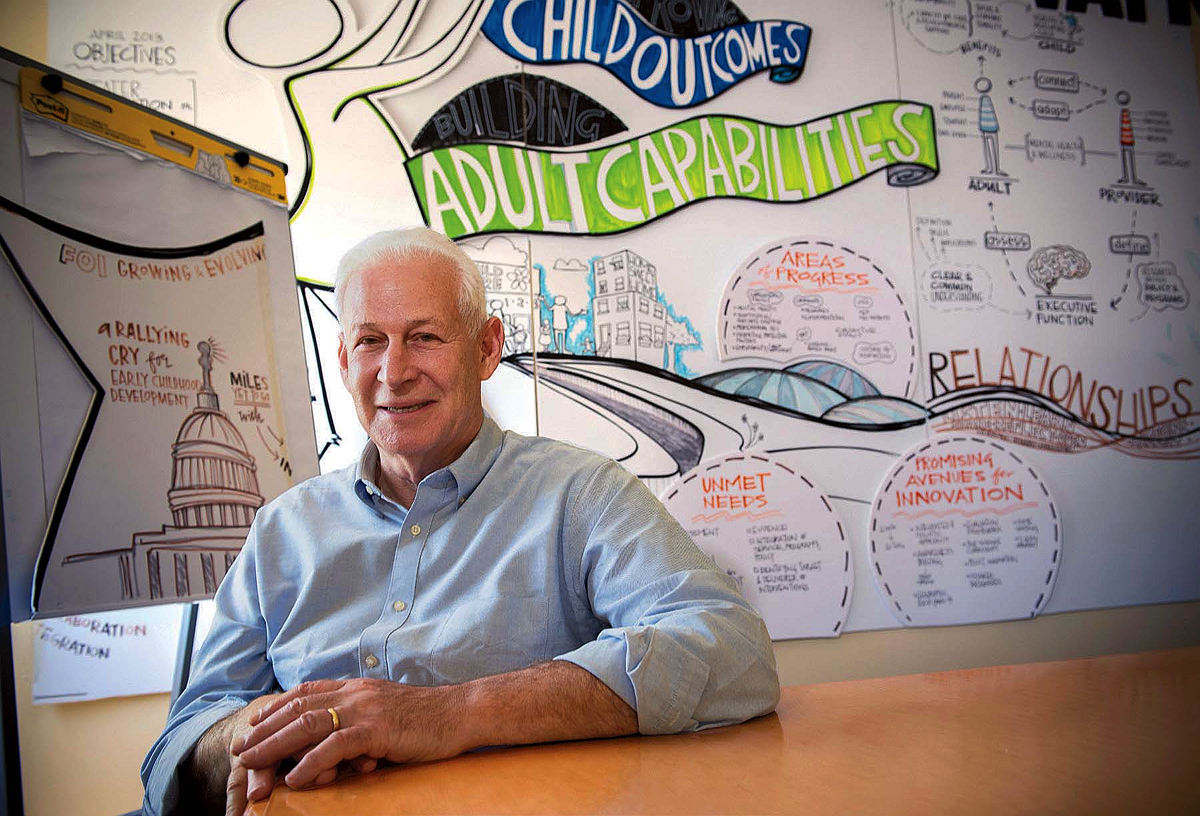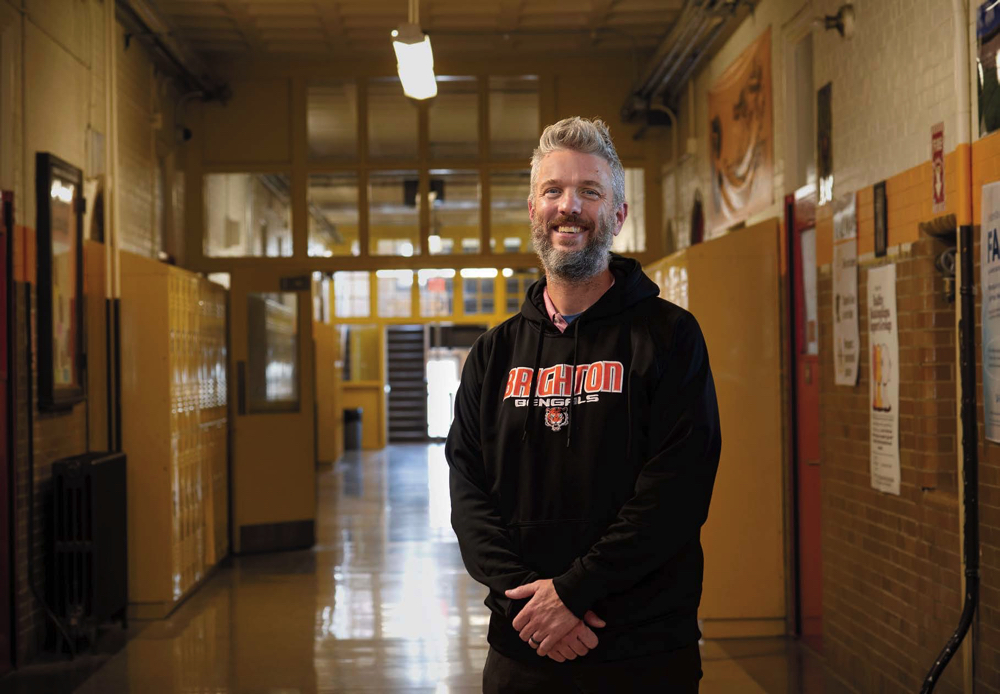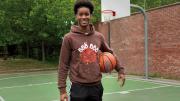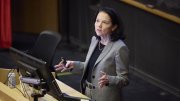During much of 2020, as the coronavirus pandemic forced closures throughout the country, Ibrahim Barry felt stuck in his head. A 15-year-old freshman hoping to play college basketball someday, he found himself with no gyms available and no school to attend. Instead, he spent much of his time following the most sought-after basketball recruits on social media. As he sat in his parents’ apartment in Boston’s Dorchester neighborhood, he watched videos of these high school standouts working on their skills in private gyms with personal trainers at their sides. He couldn’t help thinking that opportunities were passing him by. “And I’d be thinking that all day,” he said. “Sometimes I wouldn’t even speak to anybody.”
Barry had imagined getting his grades up, earning a scholarship to a private high school, and securing an offer from a Division I college program. Now, he was confined mostly to jogging around his neighborhood and doing push-ups, trying to stay in shape and expend some of his restless energy. “I was running all day, just thinking, ‘What if none of this is worth it?’” he said. “It wasn’t the stress. It was the anxiety.”
Even when he didn’t mention his feelings, his older cousins—who also served as his role models and closest friends—noticed that he was feeling off. As they waited to hear back from colleges, they encouraged him to work hard and not let himself get overwhelmed by what he couldn’t control. “Everybody’s story is different,” his older cousin Abdul preached to him. “Just remember that.”
Orchids and Dandelions
The idea that everybody’s story is different was hardly the original narrative of the pandemic, as lawn signs (and the United Nations) proclaimed that “We are all in this together.” But more than two years after COVID-19 first surfaced in the United States, it’s a useful phrase when thinking about the mental health of children. Since the pandemic began, Jack Shonkoff, Richmond FAMRI professor of child health and development at Harvard’s public health and education schools, and a professor of pediatrics, has received countless news inquiries about the mental health consequences for children. “You don’t need a fancy scientist to say, ‘This isn’t good for kids’ mental health,’” he said in a recent interview. “Is it true that there will be more children with serious mental health problems? Yes, that’s true across the board. Is it true that many children are resilient and will actually come through this okay? Yes.”
Christy Denckla, an assistant professor of psychology at the Harvard T. H. Chan School of Public Health (HSPH) who studies bereavement, trauma, and resilience, agrees that the two simplest narratives of COVID’s effects on children—of complete breakdown and unbreakable resiliency—are both far too simplistic. “These things are unfolding over time,” she said. Although some data collected from the beginning of the pandemic have emerged in academic journals, she argues that some seemingly maladaptive behaviors, like narcissism and unruly behavior, are actually helpful short-term coping mechanisms. “Sometimes acting out is a way of expressing an emotion or grappling with a stressor,” she says. “And it may seem maladaptive in the moment, but it’s actually a necessary expression for them to assimilate and to understand an extremely stressful event.” But it’s another story to say simply that kids are resilient and they’re going to be fine. “That’s a generalization that’s also wrong,” she said. “Some will, some won’t. Both of those stereotypes are dangerous.”
Shonkoff finds that what people want to hear most is not how the pandemic will affect children broadly, but how it will affect their kids. That’s difficult to gauge. “It depends on family circumstances. It depends on age. It depends on pre-existing conditions,” he said. And, importantly, it depends on natural variation. Certain children are simply more susceptible than others, Shonkoff said, regardless of external factors. He cites research by W. Thomas Boyce, a pediatrician and professor emeritus at the University of California, San Francisco who coined the term “orchids and dandelions” to classify these natural differences. “Eighty percent of the population would fall into the ‘dandelion category,’” explained Shonkoff. Even in nonideal circumstances, these children generally don’t suffer from serious mental health issues. “Orchids,” on the other hand, are much more sensitive to adversity, but can thrive in nurturing conditions.
Age also makes a difference in shaping mental health over the long term—whether a child is in adolescence, middle childhood, or early childhood. Shonkoff is especially interested in the children he feels are often overlooked: babies.
“No parent is going to sit down with a 12-month-old and have a reassuring conversation about the pandemic,” he explained. “But those babies, especially the youngest ones, are exquisitely sensitive to the environment.” When babies don’t receive enough attention and reciprocal interaction—sometimes because of a depressed parent—their blood pressure, blood sugar, and stress hormones surge. Those reactions affect the brain, disrupting the hippocampus (responsible for learning memory) but reinforcing parts of the amygdala that deal with fear and activate the stress response. “We have mountains of data on the fact that severe neglect has more deleterious effects on brain development than physical abuse,” he continued. In some ways, children just a few years older are much better equipped to handle the pandemic than a baby whose parents are struggling with mental health challenges. “If you’re in those early childhood years, you’re either going to grow strong circuits or you’re going to build weak circuits,” he said. “And that’s what you’re going to have for the rest of your life.…It doesn’t mean you can’t get better, but they’ll never be as good as they could have been.”
Social factors matter, too—like inequality. “So we know about the disparities around physical health,” said Christopher Bellonci, a Harvard Medical School (HMS) assistant professor of psychiatry and senior policy adviser at the Judge Baker Children’s Center. “But I think we’re seeing similar disparities in terms of the behavioral health outcomes of young people.” He also often works with young people with LGBTQ identities—one of several marginalized groups that has suffered disproportionate increases in negative behavioral health outcomes during the pandemic. “We think it’s got to do with increased time spent isolated from supportive networks,” he said, “and in some cases, sadly, exposure to non-affirming families.”
Complicating matters further is that parents or guardians are the most significant influence on children’s mental health outcomes (or at least among them). “The first thing that has to be asked about how we protect children from this, in terms of their mental health,” Shonkoff said, is “making sure that we’re protecting and empowering the adults who take care of them.”
Given those overriding uncertainties, are parents, teachers, and medical professionals equipped to address emerging mental health problems? According to Shonkoff, “The answer is, obviously, we are so underprepared that it’s preposterous to think about what’s going to happen.”
Massive Waitlists
Whatever the pandemic’s effect on an individual child, the population-level data are startling. In December 2021, U.S. Surgeon General Vivek Murthy ’98 released a special public health advisory about a possible youth mental health crisis. “[T]he challenges today’s generation of young people face are unprecedented and uniquely hard to navigate. And the effect these challenges have had on their mental health is devastating,” he wrote in the introduction. Before the pandemic, about one in eight kids had an anxiety disorder; in the first few months of the pandemic, that proportion doubled. From 2019 to 2021, emergency department visits for suspected suicide attempts increased by 51 percent for girls and 4 percent for adolescent boys. But throughout the advisory, Murthy also pointed out that youth mental health had already been worsening. Even before COVID-19, the Centers for Disease Control and Prevention (CDC) reported that one in five children had a mental disorder, only 20 percent of whom received care from a mental health provider. According to the CDC, the proportion of high school students who reported persistent feelings of sadness or hopelessness increased from 26.1 percent to 36.7 percent between 2009 and 2019—an increase of more than 40 percent. Those who had considered attempting suicide rose from 13.8 percent to 18.8 percent.
Though staffing and funding for mental health problems are chronically inadequate, Karestan Koenen, professor of psychiatric epidemiology at HSPH, said, “It’s never going to be a problem that can be 100 percent addressed by expanding the traditional medical system.” She continued, “We’re never going to have a system where each child who has a mental health problem has an individual therapist. It’s just never going to happen.”
This is especially apparent today. In a recent interview, Archana Basu, clinical psychologist in the department of psychiatry at Massachusetts General Hospital and HMS, discussed how hiring three new psychologists and a fellow for a new pediatric care program barely made a dent in the program’s waitlist. “I’ll just say this, even if I hired 10 new psychologists in the next month, we can fill up their panels as soon as we hire them, and we would still have a bottleneck because that’s the demand,” she said. “We can’t follow the same type of care provisions we have, which is a very tertiary-care model. We really need to move upstream. The focus needs to shift up toward preventative care and secondary and early intervention.”

Jack Shonkoff, director of the Center on the Developing Child, worries about babies’ and infants’ emotional health.
Photograph by Stu Rosner
On Koenen’s list of psychologists to whom she often refers patients, the minimum waiting time for an initial appointment is about six months; some have stopped adding patients to waitlists altogether. Koenen has found that friends and family members looking for services—even ones who have been willing to pay out-of-pocket—have encountered immense difficulties. The problem is far worse for those without the means to pay.
Katie McLaughlin, a clinical psychologist and professor of psychology, said that as therapists she knew were forced to work away from a group office space, many lost the shared infrastructure that helped them process insurance claims. Facing extreme demand for their services, some decided to stop processing them altogether, along with Medicaid claims. “There are enough people who are willing to pay out-of-pocket—maybe they get reimbursed through their insurance company—but they’re just willing to handle that on their own,” she said. She recalled a highly educated, well-connected friend trying to find mental health resources for her child in July 2021. “And I think at one point, they had called 40 to 50 providers to find someone who would accept health insurance,” she said. “I’d never heard a story like that before the pandemic, and now I hear them all the time.”
Clinics have had two main responses to this influx of patients, said John Weisz, professor of psychology in the Faculty of Arts and Sciences and HMS, whose research involves development and testing of interventions for youth mental health problems. The first is triage: in cases where immediate treatment is needed, that child is pushed to the head of the list. “But of course,” he said, “that lengthens the waiting period for the other young people waiting for care. So it’s not an ideal solution.” The second step is to add more clinicians. But even though some programs are offering signing bonuses, they’re still struggling to increase the size of their staff. “Some programs are virtually flat in terms of personnel numbers,” Weisz said, “and in fact, the number of available providers appears to have decreased significantly during this time, because some providers had to cut back on their hours or even stop providing services for a while to provide the support that their own children needed. So one result—this is nationwide—is massive waitlists.”
“The main thing that I would hope for is that there is no going back to normal—or whatever it was pre-pandemic,” said Basu. “What we need is not to go back, but to really rethink and fundamentally shift our approach to be screening and meeting needs much earlier in the developmental course.”
“Finding Much More Traction”
Some of these changes are under way. Weisz, who leads the Laboratory for Youth Mental Health, sees widespread potential for brief digital interventions (BDIs) that help children with mild to moderate mental health concerns improve their coping mechanisms. His lab, in conjunction withSchool Mental Health Ontario and the Offord Centre for Child Studies at McMaster University, currently use a group of four “coping kits” to help students. Children can complete each one in between 20 and 45 minutes.
In Project Solve, the first of the BDIs, children are encouraged to help an imaginary student manage his school-related stress. They identify realistic goals for the student, brainstorm possible solutions, and then weigh the positives and negatives of each. The session then becomes personal, encouraging children to use the same process to solve a problem of their own. Project Calm, the second intervention, helps students identify how their bodies react to stress and leads them through strategies to calm down: slow, deep breathing; relaxing their muscles; “quick calming”; picturing a peaceful place. The third, Project Think, explains how to take unhelpful thoughts, like “Nothing ever goes my way,” and replace them with more productive ones: “If I keep trying, I will give myself more opportunities.” In the final module, Practicing the Opposite, students identify harmless fears that get in the way of their lives—anxiety over raising a hand in class, nervousness around crowds—and develop a plan to address them. That could mean raising a hand in class even if the student doesn’t want to. “Our fears don’t need to hold us back forever,” one slide says. “We can change our lives for good.”
Weisz acknowledges that these digital tools are not a cure-all. “I wouldn’t want to suggest that a digital intervention…could meet all the needs for mental healthcare, particularly for serious problems,” he said. “But I think there are a lot of young people who are struggling with issues for which just a little support and help is needed.” Helping children with less severe issues online could reduce the demand for in-person professional services—leaving it for those who are struggling the most.
These free digital interventions are expanding, in overall use and number of available programs, as evidence for their efficacy builds. Jessica Schleider, Ph.D ’18, an assistant professor of psychology at Stony Brook University and former member of Weisz’s group, published a 2021 paper in Nature about how digital single-session interventions (SSIs) reduced depression symptoms, hopelessness, and restrictive eating—while increasing post-intervention agency—three months after a single intervention. Tom Osborn ’20, who worked in Weisz’s lab as an undergraduate, published a paper in the Journal of Consulting and Clinical Psychology in 2020about how an online SSI reduced adolescent depression symptoms in Kenyan children—with the caveat that more work needed to be done to determine their efficacy over longer intervals.

Beyond online interventions, Weisz sees value in training non-specialists to offer mental health support. He points to organizations like Room 13, a confidential peer-counseling service for Harvard undergraduates, and the Phillips Brooks House Association—which provides social-emotional support services to children in the Greater Boston area—as examples of this approach. Providing training sessions to those in “helping” professions—like nurses, midwives, and teachers—can also address minor problems and match children to resources before their problems become severe.
This more holistic approach to care has accelerated during the pandemic. When Andrew Bott, M.Ed ’00, was installed as the new principal of Boston’s Brighton High School in July 2020, the school had just finished an academic year that ended with a few months of extremely low child-teacher interaction. He and his colleagues decided to redesign the system. Every school staff member picked between eight and 10 students with whom they had a close relationship. Beginning that fall, teachers checked in with those children three times weekly. When the students said they needed something, a team of counselors was there to help: social workers, school psychologist, the family liaison, clinicians who work with the school through partnerships with local groups. It worked well enough that Brighton High decided to repeat the process when school resumed full-time, in-person teaching in the beginning of 2021. This time, instead of the teachers picking students to contact, the students selected the teachers.
These rapid developments in mental-health infrastructure are not specific to Brighton High. Sara Burd, director of guidance and social emotional learning for the Arlington Public Schools (APS) in suburban Boston, said that although many kids are resilient, “Unfortunately, the ones that are struggling—they are not in school.…They’re in hospitals, they’re in private schools, they have dropped out.” And the school district’s teachers are struggling too. “Teachers that couldn’t make it work under the confines of what we needed them to do left,” she said. “That’s why we’re still hiring.” But Alison Elmer, APS’s head of special education, points out that it’s hard to identify the effects of the pandemic on student mental health “because we weren’t doing mental health screenings prior to it.” She said, “Yes, we had talked about it—it’s part of the tiered systems of support. But the pandemic brought that into focus.” Such screenings, which can help identify struggling students and find them help before their problems worsen, began in 2020 and will continue yearly for students across elementary, middle, and high school.
In some cases, the pandemic has jump-started programs that had long languished. When Archana Basu arrived at Harvard in 2016, she began advocating for an integrated care model at Massachusetts General Hospital that would enable clinical psychologists to perform brief interventions, consultations, and triage for young children and their parents. Though the idea received broad verbal support, there was little progress in implementing it. During the pandemic, that changed: the program was launched in 2021. Already, Basu said, it is helping parents and children deal with isolated behavior issues of sleeping, toileting, and feeding. These interventions often take place in group-based sessions, which have proven highly effective at a fraction of the cost of individual sessions. “I think even these types of pilot programs like ours are finding much more traction now,” Basu said. “I do think the pandemic’s increased demand had a role to play in that.”
“Without Those Guys…”
For Ibrahim Barry, the pandemic turned into an unlikely time for growth. Forced out of school and his normal schedule, he began spending more time with his cousins. Though he had once dreamed of playing professional basketball, he realized—when seeing their hard work up close—that he hadn’t been doing as much as he needed to actually achieve that goal. When a peer praised his cousin for huge improvements to his basketball skills, Barry realized that he wanted to be known as a hard worker, too.
He took his online classes seriously, and his grades rose. He scrimmaged with his older cousins and their friends consistently and worked out on his own afterwards. He knew his cousins went to the gym, so he started working out, too. Slowly, he got stronger. When he returned to school last September, his grades improved further. A few months ago, he was accepted into a local private school on a basketball scholarship.
He noticed that school was a bit different in the 2021-2022 academic year. Students had less energy and treated class more like a job than a place for socializing; some of his friends from freshman year give him a wave and little more. But he notices his teachers are there for him: Ms. Coleman, a school fundraiser who leaves her office open for students to “speak their hearts”; Ms. Smith, the assistant principal who shares his skin color and helps him feel understood as a black man.
Though Barry said that many people he knew took advantage of the unusual pandemic circumstances—as they had more time for sleep and to work individually on their interests—he acknowledges that some kids who had been fine before the pandemic “dropped off.” Some became less interested in basketball and more interested in making money in illegal ways; others stopped showing up to school altogether. He credits his support system—his parents, family, and teachers—for helping him make it through stronger. “Without those guys, I feel like maybe I would have been, unfortunately, unmotivated,” he said. “Without them, I don’t think I would be the person I am.”









